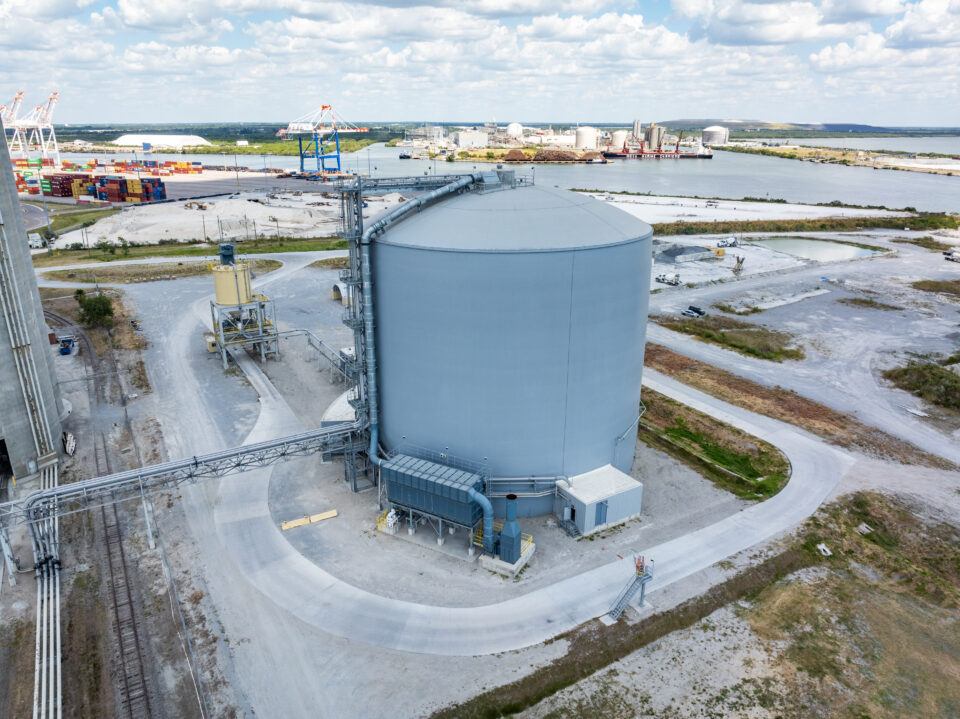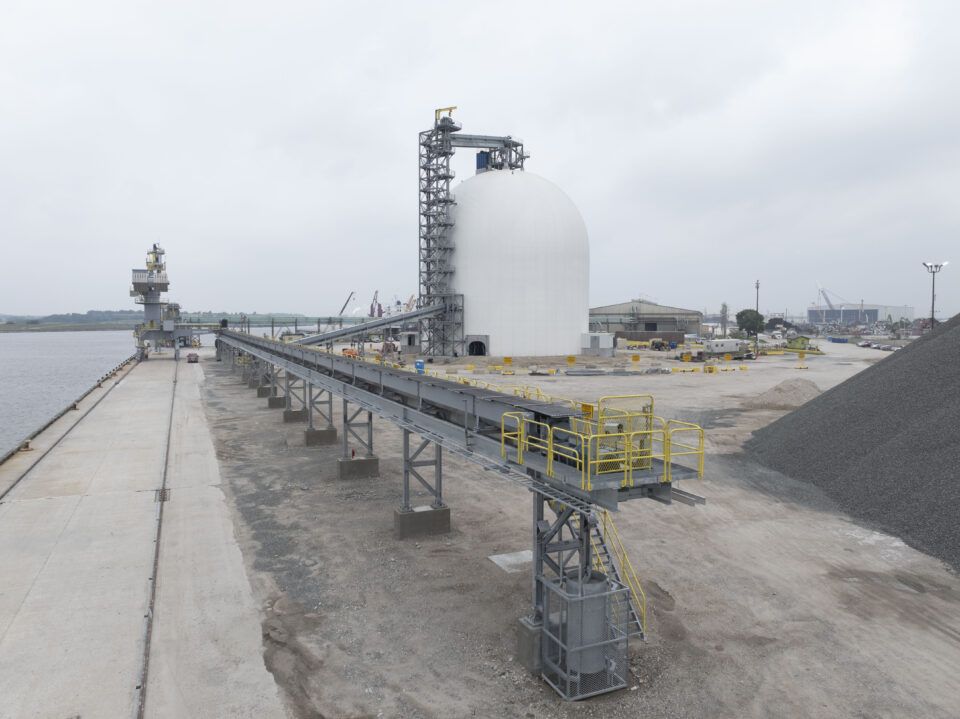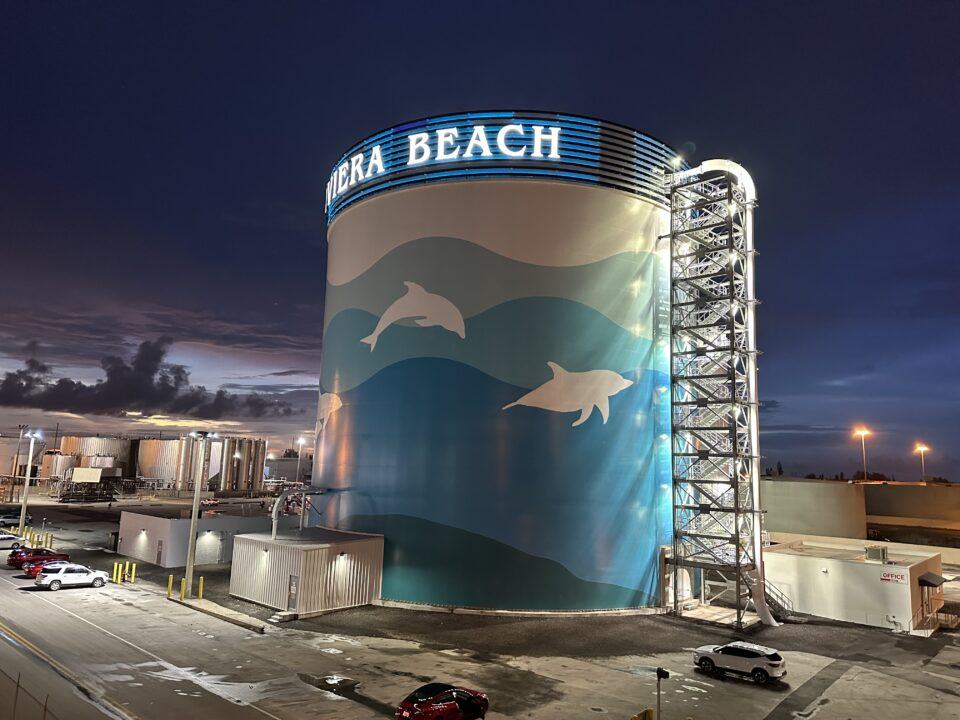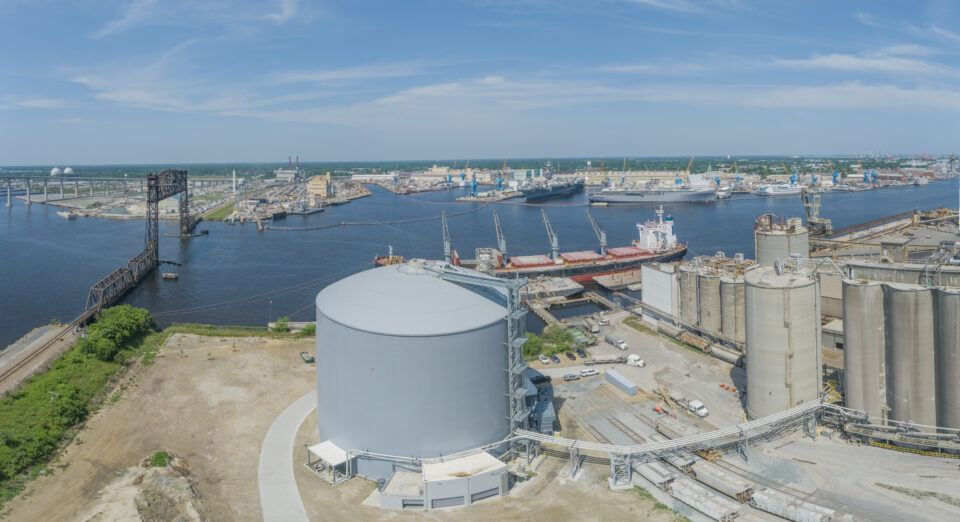If the Dome Technology project portfolio is any indication, a growing number of major players in the cement industry are choosing dome storage over traditional alternatives.
The Dome Technology team recently completed four major cement projects across the United States and is under contract for several more domestically and abroad. The dome model of choice, the DomeSilo, boasts ultimate storage capacity on a limited footprint, an indefinite lifespan and customization galore. Whether landlocked or portside, the DomeSilo allows companies to maximize their abilities at any site and is the centerpiece of the four projects discussed here.
Ozinga — Riviera Beach, Florida
During the third quarter of 2022, Dome Technology finished building Ozinga’s new cement storage dome at the Port of Palm Beach, Florida, USA.
The 50,000-metric-ton DomeSilo is located north of Miami in Riviera Beach, Florida, and has a multi-colored airform, low-profile dome roof and parapet wall. The structure’s custom appearance resulted from a cooperative effort between Ozinga, Dome Technology, the port of Palm Beach and the City of Riviera Beach to enhance the visual landscape of the area and complement the marine environment. According to Ozinga vice president of strategic development Greg Vander Velde, Dome Technology was integral in bringing the design to life.
Innovation extended beyond the exterior design. For conveyance, the DomeSilo required 1,650 feet of 20-inch piping from the ship unloader and into the dome. The transport pipe was buried from the ship to the DomeSilo to avoid existing above- and below-ground infrastructure. Dome Technology worked with Bruks Siwertell and FLSmidth to develop a new concept in ship unloading that combines a Siwertell ship unloader with an FLS pneumatic transport system. This model is now being marketed to others in the bulk industry with similar conveyance requirements.
The Ozinga facility receives and stores international shipments of cement that are then transported to other locations for use in ready-mix concrete. Ozinga has supplied cement for commercial, residential, public works, landscaping and excavation projects from its Florida locations in Davie, Doral, Miami Gardens, Miami, Deerfield and Riviera Beach since 2017.
“The dome facility is strategic to Ozinga’s ready-mix operations in South Florida. Additionally, the terminal will help secure a supply chain of cement to the regional market, support South Florida’s growth and offset the rising cost of construction,” Vander Velde said.
This is Dome Technology’s second project with Ozinga, the first being a 50,000-metric-ton cement dome in Chicago. “Dome Technology is grateful for the opportunity to be part of the solution for this unique and challenging project,” Dome Technology CEO Bradley Bateman said. “Our team appreciates the chance to work with Ozinga on another project that’s exceptional.”

Titan America — Tampa, Florida
In the final quarter of 2023, Dome Technology completed a 67,500-metric-ton DomeSilo for Titan America in Tampa, Florida. The DomeSilo is 142 feet in diameter and 141 feet tall.
The Tampa site was new to Titan, and the company had multiple priorities with its new acquisition. First, Titan wanted to maximize storage capacity despite the port’s height restriction. In response, Dome Technology fitted the DomeSilo with a low-profile domed roof that might not look like the typical dome but delivers robust strength. This allowed the structure’s vertical walls to reach as high as possible and provide the greatest possible cement storage.
“Our challenge before the dome was a full vessel of one product maxed out our capacity,” said Tampa plant manager Eric Poitras. “The dome now allows us the benefit of discharging two vessels back-to-back with different products without maxing out our storage.”
Second, the DomeSilo needed a robust dust-collection system. But it wasn’t possible to select a typical apex dust collector and still meet the capacity goals and height restriction. So project engineer EDG Inc. proposed a novel design: venting attached to the side of the dome and down to a dust collector at ground level. Not only does this eliminate the need for a large apex platform, but it also makes servicing the dust collector easier.
Another priority was maximizing the portside property. The site’s soil conditions required a deep foundation to minimize settlement, and an auger-cast piling system with pile cap provided structural security from the ground up. Because of limited space, Dome Technology designed buildings for the Fuller-KinyonÒ (FK) Screw Pump and blower that curve around the DomeSilo exterior rather than standing separate.
Double-sided discharge points at the base of the DomeSilo combined with an FLSmidth Cement Ful-FloorÒpneumatic reclaim system ensures reclaiming isn’t interrupted if one transport system is temporarily out of order. FK pumps convey product from the DomeSilo to truck loadout silos.
Dome Technology’s scope of work included designing and installing the deep-foundations system, pile cap, dome reclaim tunnel, backfill, installation of the FLS aerated reclaim system and ladder-tower and bridge fabrication, as well as the equipment buildings adjacent to the DomeSilo.
With construction complete, Titan American expects the DomeSilo will improve distribution and product flexibility into the future.
“The dome allows Titan to expand its customer base into West Central Florida by increasing the amount of cement we have available in that market. It also allows Titan the flexibility to bring multiple products into the marketplace,” Poitras said.
Titan America — Chesapeake, Virginia
Dome Technology built a 67,500-metric-ton DomeSilo for Titan America in Chesapeake, Virginia, an identical structure to one built for the company in Tampa, Florida.
The DomeSilo is 138 feet in diameter and 141 feet tall. Because the Chesapeake site had a height restriction like the Tampa site, Titan chose a DomeSilo model that “is not a complete sphere but rather a cylinder with a dome roof,” Titan corporate director of projects Nasos Economou said. Although most of the height comes from vertical stem walls, the structure still benefits from the robust strength and monolithic integrity that comes standard with a DomeSilo.
The Chesapeake dome features the same reclaim conveyance systems as the Tampa dome. Dome Technology’s scope of work also included the dome reclaim tunnel, backfill, installation of the Ful-Floor reclaim system and ladder-tower and bridge fabrication and installation.
According to Economou, Titan was able to achieve lower capital requirements by selecting a DomeSilo with its conveyance and reclaim systems. “The dome appears to be the most cost-effective solution for a single product,” he said.

Argos Cement — Houston, Texas
After considering all options, Argos Cement leadership determined a DomeSilo was the best option for its Houston, Texas, site.
“The dome gives Argos a great amount of storage in a relatively small footprint and an economical storage price per ton relative to typical silos,” said Argos project manager Steve Andersen, who oversees terminal operations.
The DomeSilo stores up to 50,000 metric tons of cement and is 125 feet in diameter and 137.5 feet tall. The Houston site brings in cement via ship and is unloaded with a Bruks-Siwertell ship unloader. Mechanical screws run from the ship unloader to the side of the dome and up to the apex. According to Dome Technology sales manager Lane Roberts, this model provides speedy loading — up to 1,200 tons per hour.
The DomeSilo features an FLSmidth Ful-Floor System with a double side-discharge floor that feeds product to the truck-loading system using an FLS Fuller-Kinyon pump, where it is made ready for delivery to United States customers.
Argos also operates a 2,000-metric-ton silo on site, and daily sales often exceed that capacity. Being able to rapidly fill the DomeSilo allows the company to increase sales, Andersen said, noting the dome’s capacity results in more attractive freight rates by allowing for larger cargo volumes, which reduces freight costs.
Argos, which has since combined with Summit Materials, contracted with Dome Technology partly because of Dome Technology’s extensive experience with similar projects. Andersen said Argos expects more environmentally friendly storage and manpower savings from the elimination of front-end loaders. Also, filling will be faster; front-end loaders can fill a structure at 90 to 100 tph, but the DomeSilo can be filled at 400 to 500 tph, he said.
The dome’s strength lies in its geometry
The dome is nature’s perfectly strong shape, and its geometry yields an unusually strong manmade structure. Once the foundation system is established, a ring beam is constructed at ground level to form the foundation for the dome. Tunnels too are formed as needed for the material-handling processes.
The PVC airform, custom sized based on the customers’ specifications, is bolted to the ring beam and inflated, forming the exterior dome shape; the fabric will remain in place indefinitely as it becomes the outer waterproofing membrane.
With the airform inflated, polyurethane foam insulation is applied to the inside. Premat steel is installed to create a grid across the entire dome surface. This premat reinforcing is embedded in the cover concrete and provides initial strength to the structure and a substrate to attach the structural reinforcing steel. Concrete is placed using the shotcrete method.
With four more cement-related projects underway in 2025, Dome Technology doesn’t expect the demand for dome storage to slow down anytime soon. “Dome Technology is equipped to provide the full package for customers from concept to completion, which is demonstrated in our cement-project portfolio,” Bateman said.
Editor’s note: The preceding is an article published in the January 2025 issue of World Cement.

